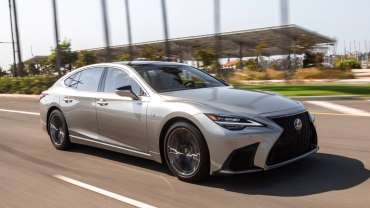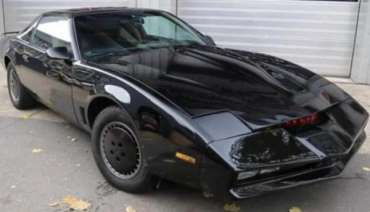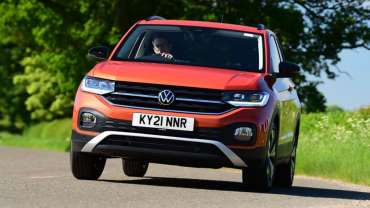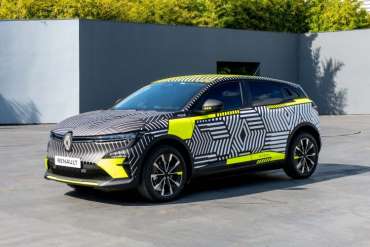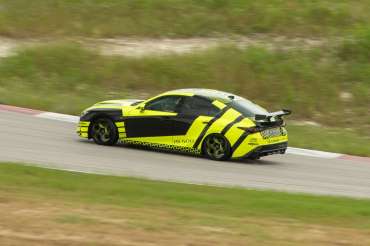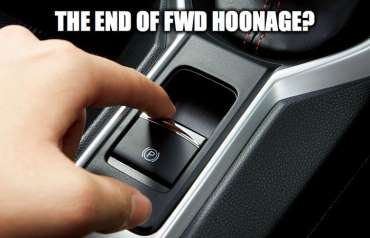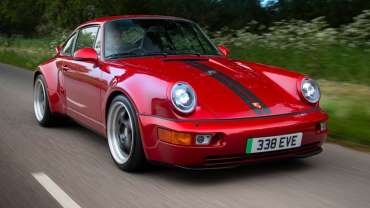
Worldcarblog.com
2022 Lexus LS500h Teammate Driver-Assist-System Review: There's No "Tesla" in Teammate
Lexus uses an altogether more comprehensive approach than Tesla does to achieving SAE Level 2 autonomy.
Tesla was first into the breach in the U.S. with a driver assist system capable of SAE Level 2 autonomy, which is the second-from-the-bottom tier of self-driving capability as defined by the Society of Automotive Engineers. (Full or close to full self-driving gets Level 4 and 5 designations.) Autopilot handles acceleration, braking, steering, and even lane changes on its own, but only on contained roads such as freeways, and the driver must monitor things. That Tesla allowed its Autopilot-equipped vehicles even that much autonomous leeway with the meager sensor package onboard raised eyebrows—all the more so when you consider what Lexus is bringing to the table with its SAE Level 2 setup dubbed Teammate.
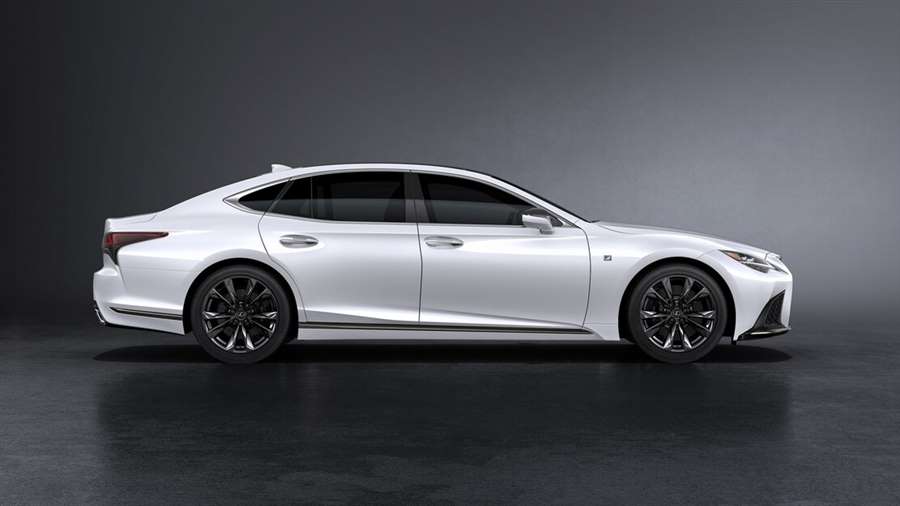
It's The Sensor Package, Stupid
Is Lexus late? Sure. Mercedes-Benz has offered similar capability to Autopilot for a few years now, including automated lane changes. But like Mercedes (which also trailed Autopilot), Lexus is coming in much better prepared.
Consider what Tesla works with: Its Autopilot-equipped vehicles (at least, before its recent abandonment of a forward radar sensor in the Model 3 and Model Y) include front, rear, and side-facing cameras, plus 12 near-range ultrasonic sensors (i.e., parking sensors). The larger Model S sedan and Model X SUV still include a forward-facing radar sensor, but Tesla has been pretty clear about the fact its onboard computers favor inputs from the cameras when scanning the road ahead.
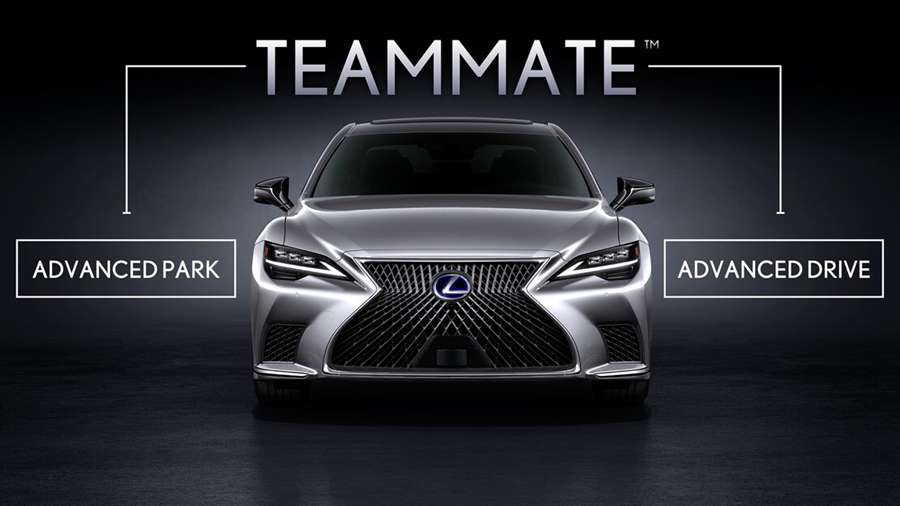
Now consider what Lexus' first go with Teammate brings to the table: Front-facing Lidar, front-facing long-range radar, short-range radar facing the front and blind-spot areas (three directions in total), 360-degree parking cameras and ultrasonic sensors, a forward camera, and a front-facing telescope. Both Teammate and Tesla's Autopilot deliver a 360-degree view of the vehicle's surroundings, but one is like having Terminator vision, and the other is the relative equivalent of waving a stick around yourself while blindfolded.
Although Tesla claims its cameras can deliver "powerful visual processing at up to 250 meters of range," that performance is limited to certain conditions. Camera performance deteriorates in bad weather, whereas radar—so long as the sensor isn't physically blocked by, say, ice or packed snow—can detect fast-moving objects in rain or sleet. Every sensor has its limits, of course, but there's something reassuring about the multiple redundancy built into Lexus' setup, wherein overlap exists in the viewpoints of the Lidar, radar sensors, and cameras.
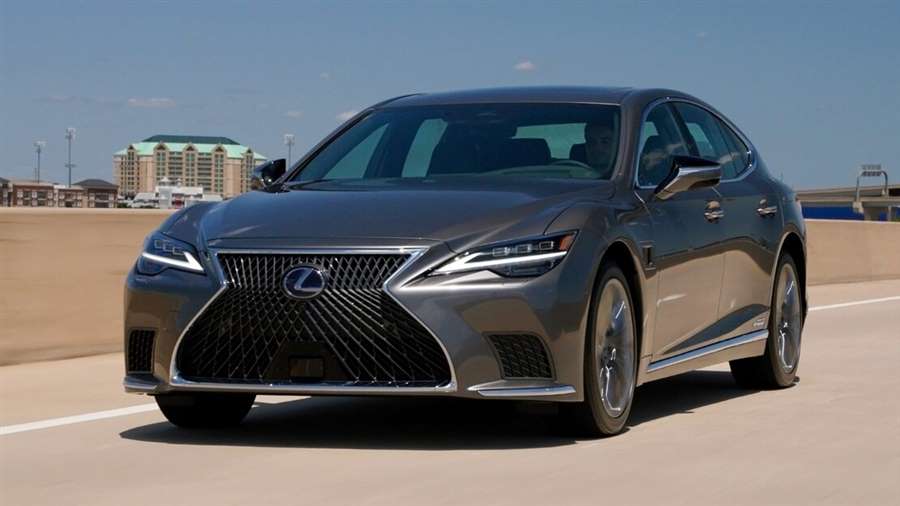
No matter how comprehensive the sensor package, eventually the driver will need to retake control for some reason or another. These are, after all, SAE Level 2 systems that demand the driver's attention at all times. Teammate is, predictably, more upfront about policing the driver's attention during use. An infrared camera above the steering wheel monitors the driver's head movements and eyes to make sure they're paying attention at all times, even while the system is working.
Like Tesla, Lexus relies on sensors in the steering wheel that detect the driver's grasp; with Teammate, you can go extended periods hands-free, but as soon as the system deems the driver is needed again, those hands better get to the wheel, quick, or else the car will begin to slow down and pull over.
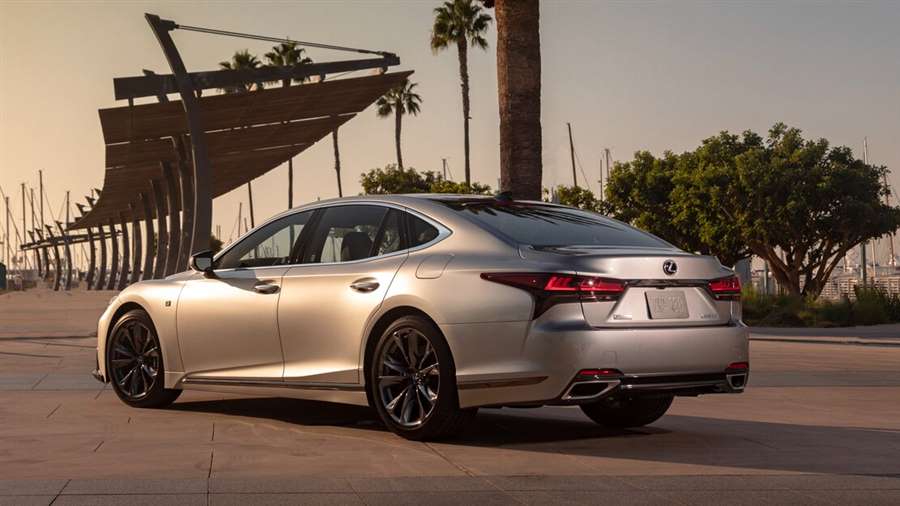
Tesla, on the other hand, only recently began actually using the included in-car camera to track the driver's involvement in the Model 3 and Y; the Model S and X hadn't even included the cameras until their recent refresh. This lack of monitoring has made possible those moronic YouTube videos you may have seen showing Tesla drivers able to climb into the back seat, or even go to sleep, with Autopilot active, and with disastrous results.
So, How Does Lexus Teammate Work?
The short answer? It works well. The longer answer is, it feels like a future-looking driver assist designed by Toyota. In other words, the system truly acts as a driver's partner and less like a carefree system a driver activates and simply tunes out from for a while. There is an abundance of communication from the car about where on the spectrum of involvement the driver is or needs to be in a given situation, too.

On a brief drive in Dallas near Toyota's Plano, Texas, headquarters, we experienced Teammate's two primary operating modes: Advanced Drive navigated, and not navigated. One can plug a destination into the nav screen, and, should the route take you onto an eligible freeway, you'll be given a heads-up that Advanced Drive will soon be available as you approach an on-ramp. A distance countdown in the head-up display shows you exactly how far remains until hands-free driving is possible. Once on the freeway, a message flashes in the gauge cluster alerting you the system is initializing.
After a few seconds, if everything's gravy, a graphic in the gauge cluster turns blue and an audible alert invites you to activate Teammate's Advanced Drive function. Simply press the corresponding button on the steering wheel, and the system leaps into action, taking control of steering, braking, and acceleration at the speed you were traveling when you pressed the button. Drivers can use the cruise-control adjustment to increase or decrease their set speed.
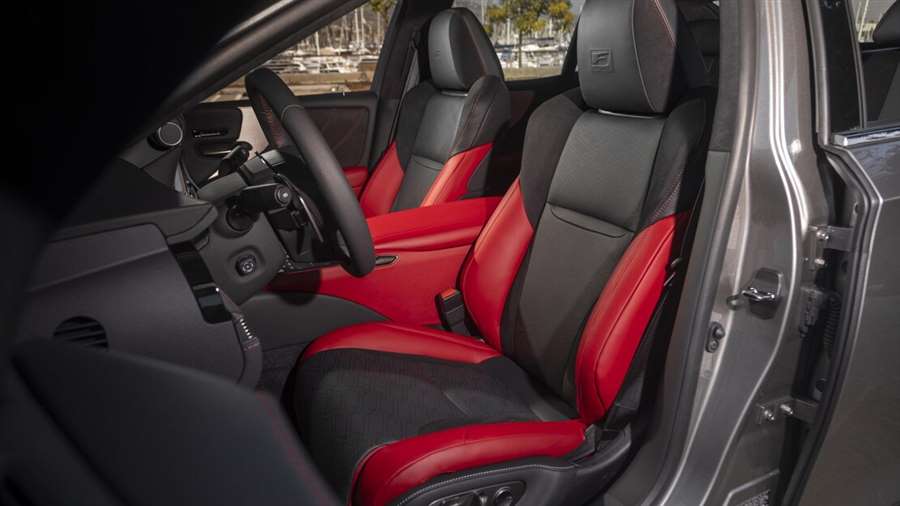
Again, with a navigation destination set, the system alerts the driver when their exit is approaching; it determines and displays decisions 6 miles ahead of time, with exit urgency growing within 2 miles of an off-ramp. It prompts you to monitor lane changes toward that exit (if the car isn't already in the right lane). Intriguingly, the car won't simply accept a lane-change instruction (you can tap the signal stalk in the direction you'd like to go) or change lanes without you: Either way, it beckons you to check the mirrors and "blind spot." Fail to get this head-turning choreography right (remember, the in-car camera is watching!), and Teammate won't follow through. It's not that Teammate can't handle lane changes on its own: With rear-facing radar on each side, it can make sure a car isn't fast approaching in your blind spot and size up gaps in traffic. That's something Autopilot relies on parking sensors and a camera for. But Teammate will only do its robot thing with your participation.
Approaching exit ramps or forks in the freeway, Teammate will slow the vehicle and steer into the appropriate lane. The same distance countdown that shows your proximity to Advanced Drive-eligible freeways counts down the distance in feet remaining before the driver must take control. Teammate will guide the car fully down an off-ramp until this handoff. Fail to take the wheel, and the car cinches the seatbelt a few times to get your attention and sounds audible warnings before slowing rapidly. Tap the gas or brake (or press the Advanced Drive button on the wheel), and it hands you control. Using Teammate without navigation is much the same, minus the steering toward exits or through forks and without countdowns into and out of system eligibility.
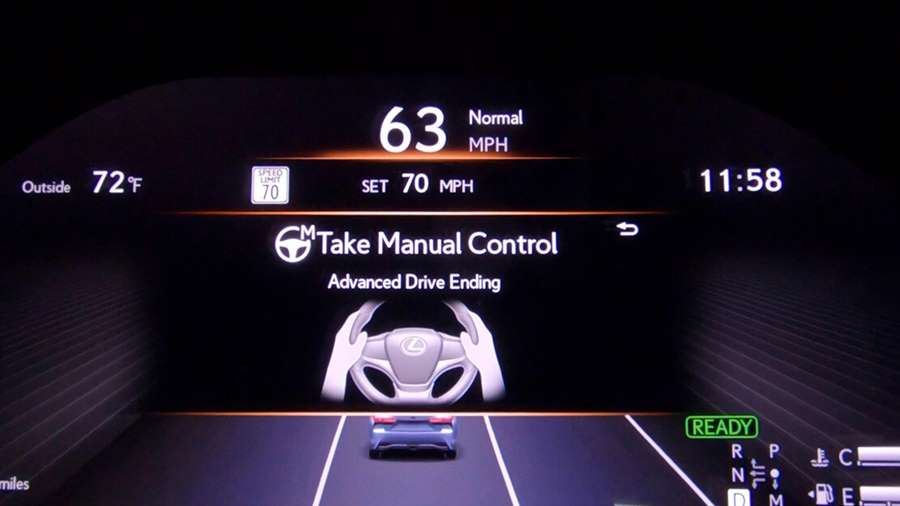
Clever And Reassuring
As with Tesla's Autopilot, Lexus Teammate uses the digital gauge cluster display to depict the Lexus positioned within lane markers (those are the lines that turn blue when the system is active), as well as animations of surrounding vehicles and objects. The similarities end there. In Teslas, the animated onscreen version of events surrounding the car are jerky, and nearby vehicles fade in and out of the Tesla's field of vision. In the Lexus LS500h with Teammate we drove, objects nearby were rendered smoothly and accurately on screen, inspiring more confidence that Teammate knew what was going on.
The system's driving smoothness, too, inspired even more confidence. Our Lexus remained precisely in the center of its lane unless—and this was impressive—a vehicle next to it got too close or wandered over the lane marker, spurring a gentle readjustment to maintain distance. At one point while Teammating in the right-hand lane, a Ford Explorer barreled down an on-ramp and looked like it was about to cross into our lane early, before the solid painted line separating the lanes gave way to a dotted one. As the Explorer was more or less even with the Lexus, we figured the car would crank the brakes and let the SUV cut in (likely taking the car following us by surprise) or, maybe, not see the situation developing and we'd be sideswiped. Instead, the LS500h deftly faded to the left and accelerated (we were traveling at less than our set speed at the time) past the wayward Explorer. It's what a smart human would have done had one been driving.
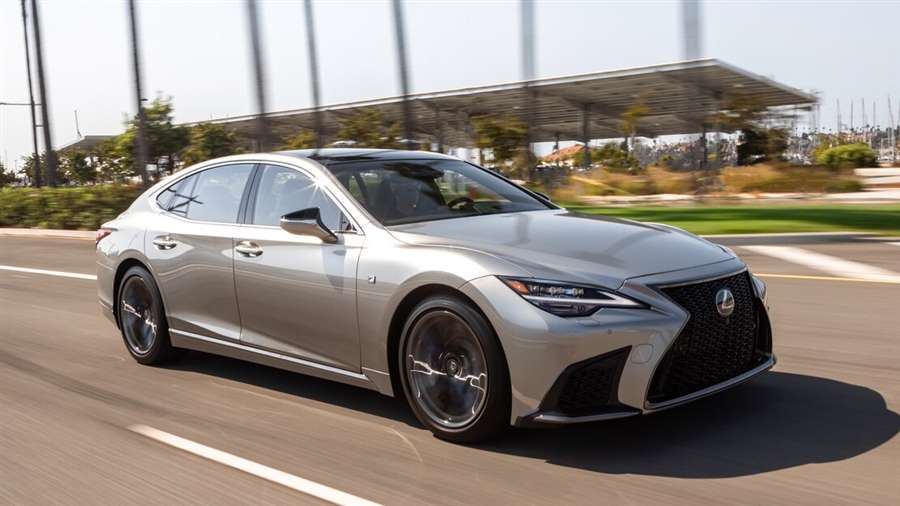
Interestingly, Advanced Drive will beckon you to participate now and again, mostly when it isn't entirely sure of its surroundings. It won't necessarily ask you to retake full control, however. There exists an in-between state where the car will continue steering, braking, and accelerating, but it asks for your hands on the wheel. (The animated lane markers in the gauge cluster turn gray in these instances.) Should stuff really hit the fan—or you reach the end of an exit ramp after leaving the highway—a series of visual and audio warnings urge you to retake full control. In all, the setup's feedback loop bolstered its apparent capability, leaving us far more comfortable than in other similar combinations of adaptive cruise control and lane-keep assist.
Teammate Going Forward
Lexus Teammate and Advanced Drive makes its debut on the 2022 LS500h hybrid sedan this fall. It also includes an Advanced Park function that fully handles parking, including steering, throttle, and braking (we didn't have the chance to try it). We suppose, over time, the feature will spread beyond the LS flagship sedan to other Lexus models, but Lexus has not yet specified its next steps. Curious how you'll spot a Teammate-equipped Lexus? Look for the little radar sensor units on each front fender (they look like vents but face rearward). Oh, and the driver may not be holding the wheel.
(motortrend.com)
David Hasselhoff and his powerful model from the legendary Knight Rider series
Fans of the cult series from the eighties, Knight Rider, were very honored when David Hasselhoff recently appeared on the Kelly Clarkson show.
Hasselhov was part of Clarkson's "DRIVE-INterview" sequence, in which guests, practicing social distance, stay in the car during the conversation. The innovative part of The Kelly Clarkson Show has previously hosted fascinating machines such as the 1970 Dodge Challenger, Jay Leno and Kurt Bush in its fleet of former competitive models.
Of course, Hasselhov appeared in K.I.T.T. model, although it is clear that this is a replica, because the original models used in the shooting can no longer be found. To be in line with the Trans Am model, Clarson appeared in the classic American Pontiac model. Until recently, the actor owned a personal K.I.T.T. which is also a replica and was not used in the original series, and was recently sold for a whopping $ 300,000.
When it comes to the relevance of the Knight Rider series, Haselhof argues that today’s technology is exactly what the team behind it envisioned forty years ago. “Cars talk, they’re completely autonomous, they can park on their own,” Hasselhof said. He also commented on how at the time of filming the popular series, cars did not go through CGI processing for their stunts and offered to teach Clarkson how to make a proper J turn in minutes.
He went on to confirm that this series will get a modern edition, which is currently in production, but this is not the first time that fans of the old title have heard the same story. The last attempt to shoot a new series was canceled by the NBC house after only one season, while Haselhof appeared only briefly in the pilot episode.
{vembed Y=cUGiEjGptZo}
Back in 2014, there was information that the shooting of the film was also in the spotlight, and it was supposed to feature John Cena and Kevin Hart, as the main duo who would be in charge of the comic reinterpretation of the genre. Although all the news that appeared then has completely evaporated to this day, the latest reports state that the ribut is actually in development and that James Van, the director behind the Fast and Furious 7 titles, is behind it. Hasselhoff confirmed earlier this year, in an interview with Consequence Film Publications, that screenwriter T.J. Fixman is also behind the new sequel, but he still doesn't know if he will return to play the main character of this cult car series, Michael Knight.
New Volkswagen T-Cross Black Edition 2021 review
The small Volkswagen T-Cross SUV turns on the style in new Black Edition trim
Verdict
Black Edition trim is a useful update to the T-Cross line-up, adding some additional styling touches for not much extra. It’s a solid small SUV with some good tech – although we wish more of it was standard. However, we can’t fault the excellent powertrain when it comes to refinement and performance, while flexibility, practicality and efficiency are sound, too.
To keep its T-Cross compact SUV feeling fresh in an incredibly crowded class, Volkswagen has updated the range, adding new trims – including an Active model – and this, the T-Cross Black Edition.
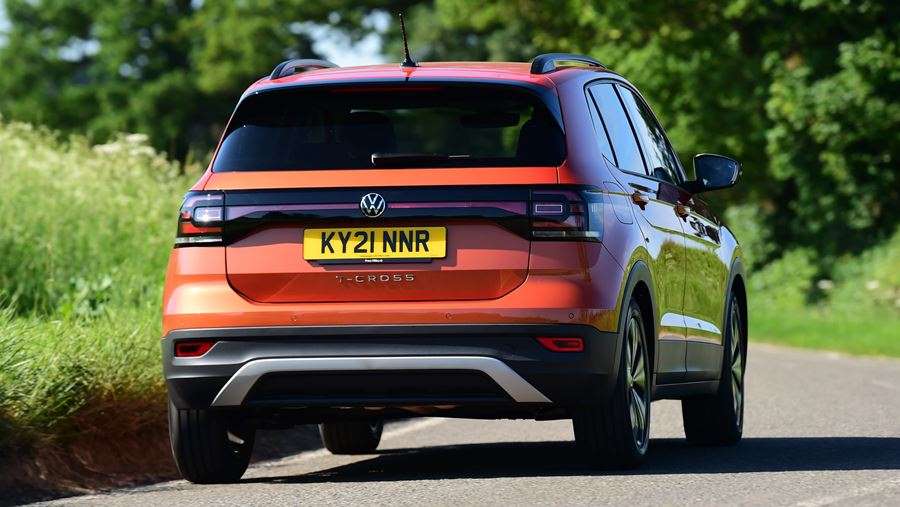
It’s identical to the rest of the range mechanically, available with the same 1.0 TSI turbo petrol in two power outputs (though not the range-topping 1.5 TSI), and either manual or dual-clutch automatic gearboxes, depending on which version you go for.
However, image is important in this class, and Black Edition trim – as its name suggests – adds some key visual extras, including 17-inch black diamond-turned alloys, black door mirrors and some dark tinted windows, plus some extra kit over the SE model it’s otherwise based on, including full LED headlights and all-round parking sensors.
The 108bhp 1.0-litre TSI 110 we’re testing will be a big seller, not least because it comes with a six-speed manual gearbox as standard, whereas the lower-powered 94bhp model makes do with a five-speed transmission.
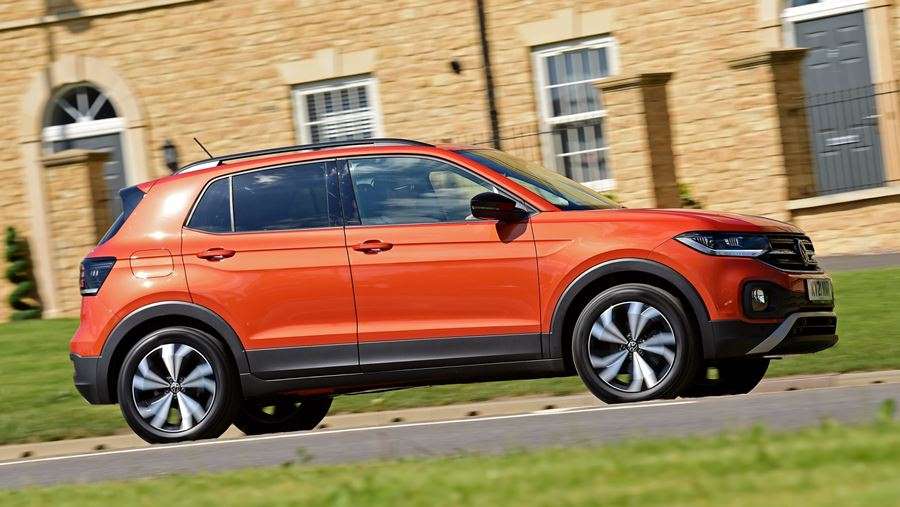
It’s an extremely refined engine as it is, but this extra gear – plus a useful 200Nm of torque – helps cruising refinement. The TSI 110 unit pulls smoothly and in a linear way; there’s not much turbo lag, just a smooth slug of torque that gets the T-Cross moving fairly swiftly and without any fuss from under the bonnet. The 0-62mph sprint takes 10.8 seconds, but it’s the flexibility that makes this a pleasing small SUV to use.
It’s coupled to good ride quality that only starts to become ruffled on bad country roads at mid speeds – it’s actually better the faster you go on this type of tarmac. Otherwise, the T-Cross is direct and agile enough to drive, with light steering and plenty of composure that means you can drive it faster than you might think.
Not that many owners will do this, and in everyday driving the T-Cross is a strong all-rounder. There’s a fair level of space in the rear of the cabin and a 455-litre boot, so small families shouldn’t feel the need for more space.
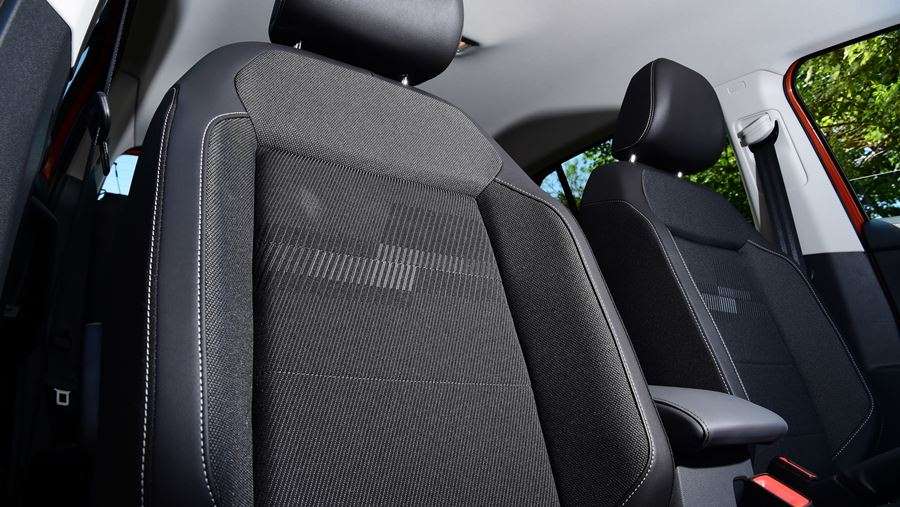
A sliding rear bench means you can prioritise either rear legroom or luggage space, so there’s a good level of flexibility. Along with the extra design touches here it shows that VW knows how small SUV buyers use their cars, offering an extra element of usability to help fit with the lifestyle crowd. It’s just as much a small family car as well, though, and we’d say that it offers a decent amount of practicality for most buyers in this class.
There’s just enough standard kit, too, given our test car’s £21,760 starting price. On top of the features mentioned above, Black Edition models benefit from adaptive cruise control, pedestrian detection with autonomous emergency braking, plus lane assist and blind-spot detection, as well as manual air-conditioning.
An eight-inch touchscreen infotainment set-up with wireless Apple CarPlay and (wired) Android Auto connectivity is included too. However, it’s a shame that VW charges £385 for its 10.3-inch Digital Cockpit Pro dash panel. Built-in sat-nav also costs £860, but it’s an extra we’d do without, given that many buyers will connect their smartphone anyway.
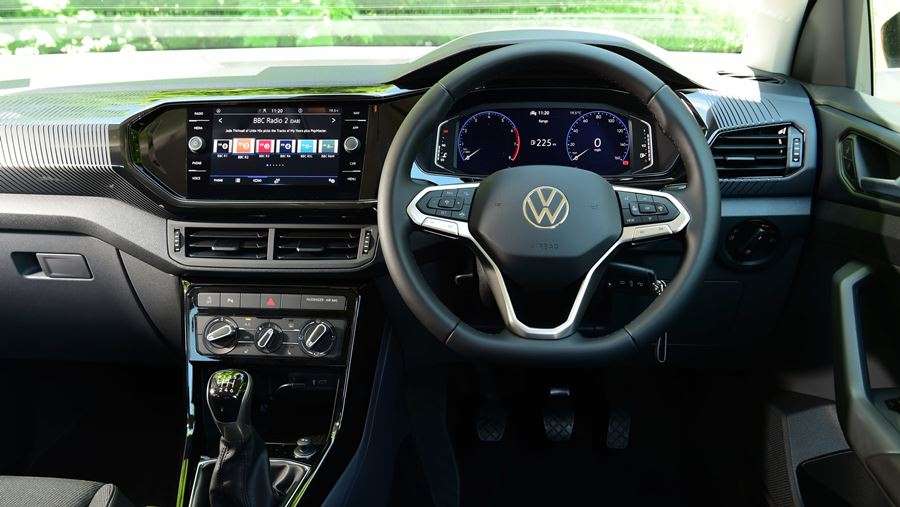
The infotainment works well, with the kind of snappy responses and sharp graphics on the main screen that we’ve come to expect from VW. The optional digital dash could still offer a higher resolution, though.
With a range of bright exterior colours to choose from, you can make your T-Cross stand out – or if you’d prefer to blend in, then there are darker hues, too.
Quality is fine, but nothing special and there are better small SUVs on sale when it comes to materials and finishes inside. But despite VW’s cost cutting in some areas, the T-Cross still feels solid enough at this price.
Its efficiency contributes towards its ability as an all-rounder as well, with WLTP-tested economy of 49.6mpg combined. This is the same as the less powerful 94bhp version, while the TSI 110 model’s 130g/km CO2 output is 1g/km better too, although this doesn’t change company car tax ratings.
Given there’s only a £725 difference in price we’d go for this more powerful model, because there’s no real penalty when it comes to running costs.
| Model: | Volkswagen T-Cross 1.0 TSI 110 Black Edition |
| Price: | £21,760 |
| Engine: | 1.0-litre 3cyl turbo petrol |
| Power/torque: | 108bhp/200Nm |
| Transmission: | Six-speed manual, front-wheel drive |
| 0-62mph: | 10.8 seconds |
| Top speed: | 117mph |
| Economy: | 49.6mpg |
| CO2: | 130g/km |
| On sale: | Now |
A radical change: The new Renault Megane is an electric crossover
We were told a few months ago that we can forget about the Renault Megane as we knew it so far. However, the new generation of the once popular hatchback still wants to maintain the tradition, but only in one thing - to remain in demand. And as trends have changed, it can only do so if it becomes a crossover and an electric one. So, goodbye for the hatchback and SUS engines, these are the official photos of the Megane prototype. However, it is still under camouflage because the premiere is awaited, and the start of production of the serial version will be in 2022.
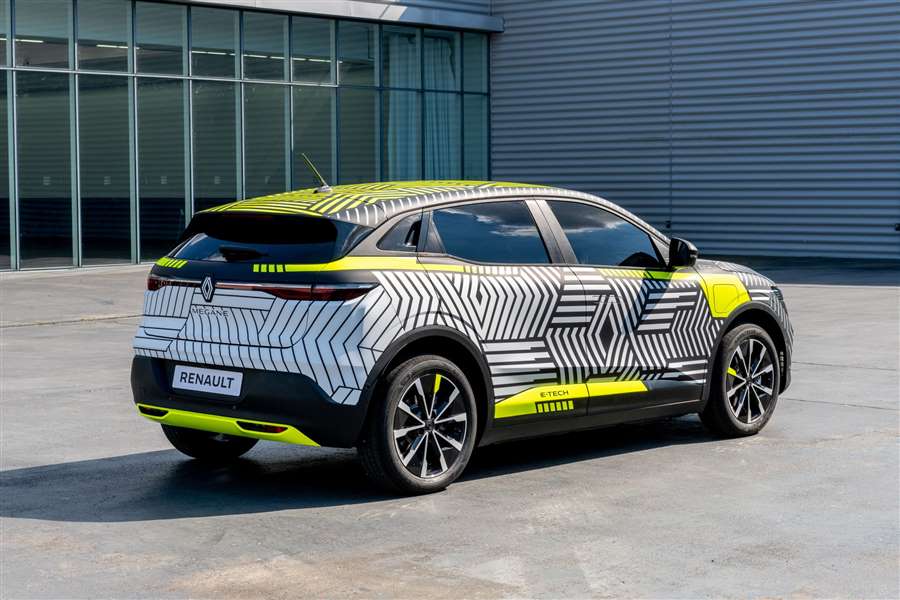
The French manufacturer showed us a prototype of the new Megane. The cunning plan to use the name Megane for a model that has nothing to do with the previous one, was coined just to help the new crossover establish some connection with previous Renault cars.
This is a pre-production model that is still camouflaged, but you can clearly see the form of the crossover, which will be the first in the alliance to use the CMF-EV platform, writes Index.hr. It is the same base used by the electric Nissan Ariya.
Renault is not revealing much data for now, but it is announcing that MeganE will have an electric motor with a power of 217 hp and a battery with a capacity of 60 kWh, which will provide a range of 450 km.
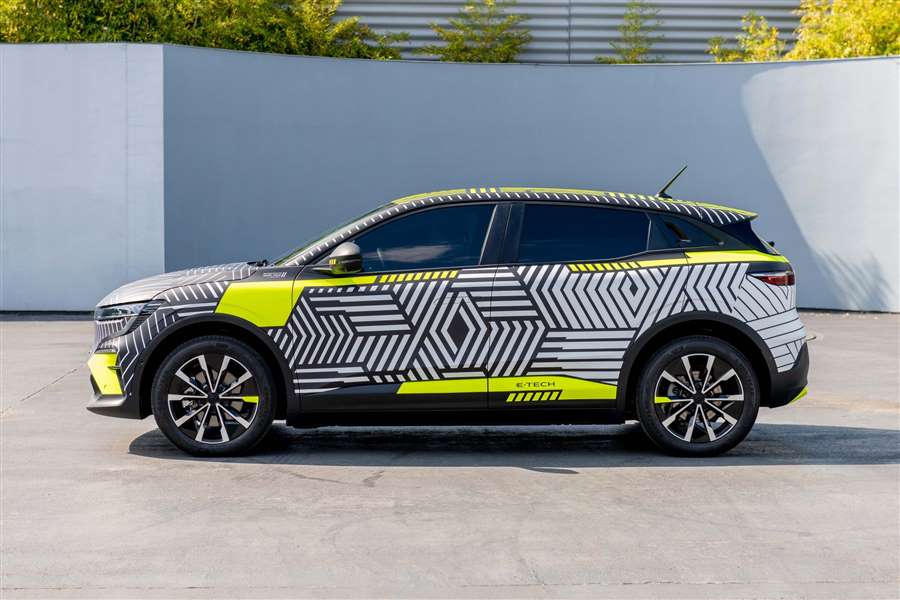
It is not yet known whether, like Ariya, they will get a version with two electric motors that has over 300 hp, but also a 87 kWh battery. Judging by what the rivals offer, it should offer such a variant as well.
In any case, the first 30 camouflaged copies Renault will release on European roads this summer.
The new model will be produced in French plants (Douai), starting next year.
2022 Lexus IS500 Brings Back the V-8
The newest F Sport Performance version of the IS takes us back to the golden era of compact sports sedans with naturally aspirated V-8 engines.
About a decade ago, compact sports sedans offered naturally aspirated V-8s that absolutely ripped. Before everyone went turbo, the E90 BMW M3, the B7 Audi RS4, and the W204 Mercedes C63 AMG crammed in sweet-sounding V-8s to create experiences that we still remember fondly today. Now that we're feeling sufficiently nostalgic for those four-door screamers, we'll get to the point that Lexus apparently shares our passion for those cars, because the new 2022 IS500 is essentially a return of Lexus's V-8 compact sedan, the IS F.
There are no turbos under the IS500's hood. What is under there is closely related to the IS F's 5.0-liter V-8 from a decade ago. The engine—shared with the RC F—now produces 472 horsepower and 395 pound-feet of torque, or 56 more horsepower and 24 more pound-feet than its spiritual predecessor. In a turbocharged world, the V-8's horsepower and especially its torque numbers aren't at the level of the M or AMG models', so Lexus is setting expectations by positioning the IS500 as an F Sport Performance model rather than a full-blown IS F.
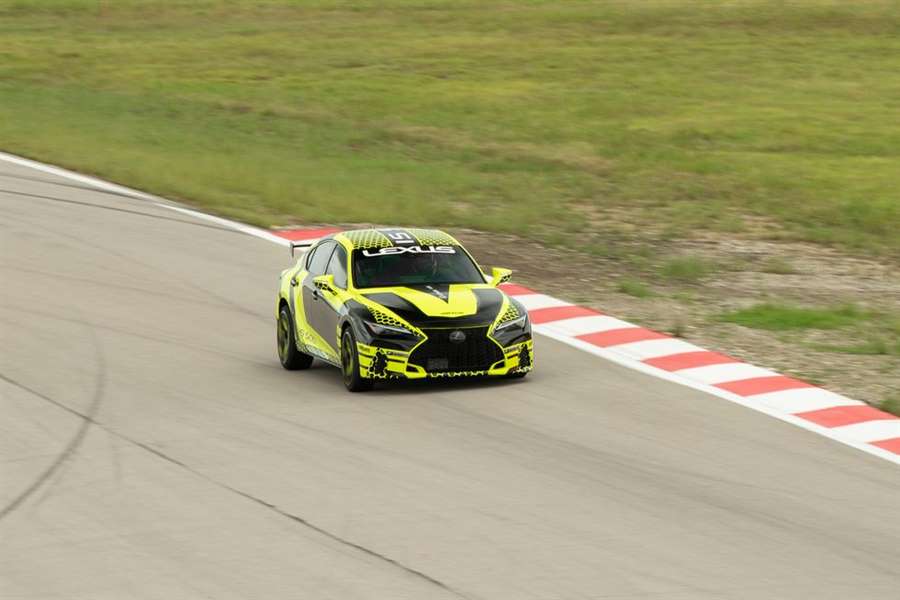
What does that mean for the IS500's driving experience? We can't quite say yet, but we did recently get the chance to ride in the passenger's seat of the IS500 prototype at an event at Eagles Canyon Raceway in Texas, near Toyota's headquarters in Plano. Professional race-car driver Townsend Bell was behind the wheel.
Keep in mind that the IS500 prototype we rode in wasn't exactly the same car that you'll be able to buy at Lexus dealerships later this year. Wrapped in an obnoxious neon-yellow and black livery, this car was specially prepped for the IS500's debut at Sebring International Raceway earlier this year. It wore an aftermarket exhaust, 20-inch wheels, and grippier Michelin Pilot Sport 4S summer tires compared to the stock car, which will have 19-inch wheels and the same Bridgestone Potenza S001L summer tires as the IS350 F Sport with the handling package.
This means that our impression of the IS500's handling isn't exactly representative, but we weren't behind the wheel anyway. We can tell you that the 5.0-liter V-8 engine is a lovely addition to the latest IS and brings back a lot of those tingly V-8 memories. We're familiar with the glorious sound of this Lexus V-8 by now, and it makes itself known in the IS500. Although the prototype's aftermarket exhaust surely enhanced the auditory experience, we'd still rather listen to this characterful engine run up to its 7300-rpm redline than a BMW M3's twin-turbo inline-six.
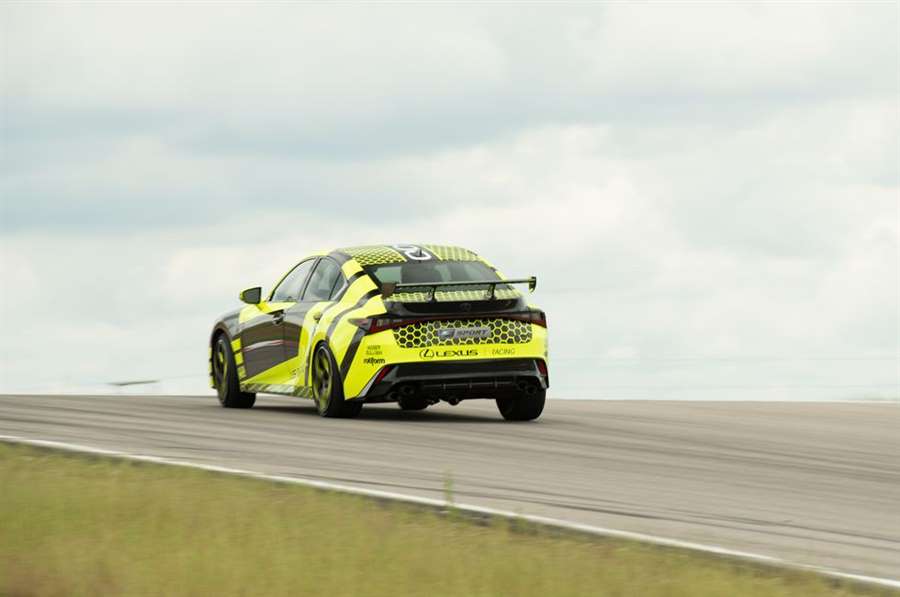
Unlike the V-6-powered IS350 F Sport we drove that day on the test track, the V-8 has the grunt to shove you into the back of your seat, and the eight-speed automatic transmission upshifts and downshifts quickly. Lexus claims that the IS500 is 143 pounds heavier than a rear-wheel-drive IS350, and we assume that most of that weight is in the nose. Like the IS F that came before it, a noticeable hood bulge is the clearest sign that this is packing something special under there.
Thanks to the ability to completely deactivate stability control, the IS500 will play as much as you like—as Bell demonstrated by easily swinging the tail out wide for a satisfying drift. It also features the same torque-vectoring rear differential that's optional on the IS350 F Sport. But this car is not meant to be a track monster, and we felt plenty of compliance in the suspension tuning, with more body roll than you'd find in an M3 Competition or a C63, for instance.
We're enticed by the overall package that the IS500 promises to deliver, and we hope that the price is attractive enough to further increase its enthusiast appeal. Lexus has strongly hinted that it will be positioned closer to the M340i and AMG C43s of the world, meaning it could bring back a V-8 to the low-$60,000 range. If so, this could become the hidden gem of the sports-sedan world. Now all that's left is for Lexus to let us in the driver's seat.
(caranddriver.com)
How the electric parking brake works: What happens if you activate it while driving?
The brake mechanism is hydraulic or mechanical and will not be released when the battery is discharged.
Most cars you can buy on the market today have electric parking brakes. Parking brakes are becoming rarer. How do electric parking brakes work? They make it easier to move uphill and downhill because they block the wheels until they have enough torque to start the vehicle.
What if you pull the electric parking brake switch while driving? Will the same thing happen with a handbrake? No, it will not, because the control unit in the car recognizes this situation as braking the car and there is no wheel lock. The electric brake then applies force at intervals, ie the ABS is activated. Basically, concentrate and don’t pull the electric parking brake switch while driving.
The brake mechanism is hydraulic or mechanical and will not be released when the battery is discharged. That is, no electricity is required to maintain a firm brake grip.
Everrati Porsche 911 (964) Signature review: retro electric 911 tested
With stricter emissions regulations, combustion engine bans coming into force in the future and changing attitudes to electrification, the restomod scene has exploded with new electric possibilities. You can now get no end of classic cars modified or completely overhauled to run on e-power.
But Everrati is convinced its electric creations aren't as simple as just swapping out a combustion engine for an electric powertrain.
'We take some of the world's most beautiful and seminal cars, restore and re-engineer them, always operating with full respect for the brands that created them,' says Everrati boss, Justin Lunny.
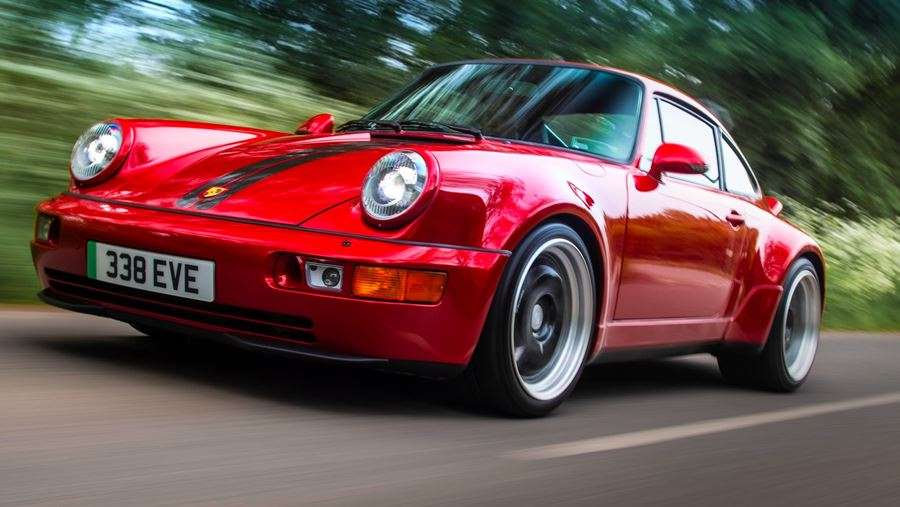
We've driven a prototype of Everrati's latest creation – a 964-generation 911 – to see if an electric icon can really work.
What's Everrati?
It's a technological and engineering company founded in 2019, designed to cater to those who want to keep their classic cars but make sure they're ready for the electric age. The company has had previous projects with the Mercedes SL and Land Rover Defender and, more recently, has diverted its attention to classic and retro generations of the 911.
But what Everrati strives to do is not just restore and redefine a classic by making it electric but keep as much of the DNA from the original as possible. Fun is the priority here, with Everrati seeing the benefits of an EV powertrain like instant torque and throttle adjustability being front and centre with its sports car projects. The advantages of holier-than-thou zero-emissions running, cheaper running costs, (predicted) cheaper maintenance costs and the ability to whizz around clean air or congestion zones for free are mere bonuses.
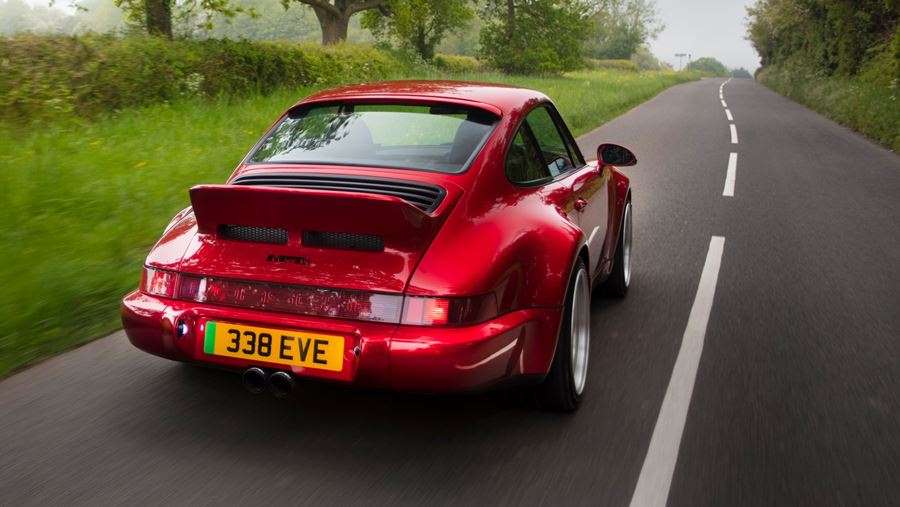
So, with this 964-generation 911 project, the targets have always been about maintaining the car's weight and weight distribution, its retro looks and its Porsche feel inside.
So how has Everrati done that?
You'll need at least £250k to start the process. The team take a 964 donor car (either one you already own, or one Everrati will source for you to perform the restoration on for an extra cost), strip it down to parts and water blast, then rust protect, the chassis, seam-welding it in the process. The front and rear wheelarches, doors and bonnet are recreated with carbonfibre to keep weight down.
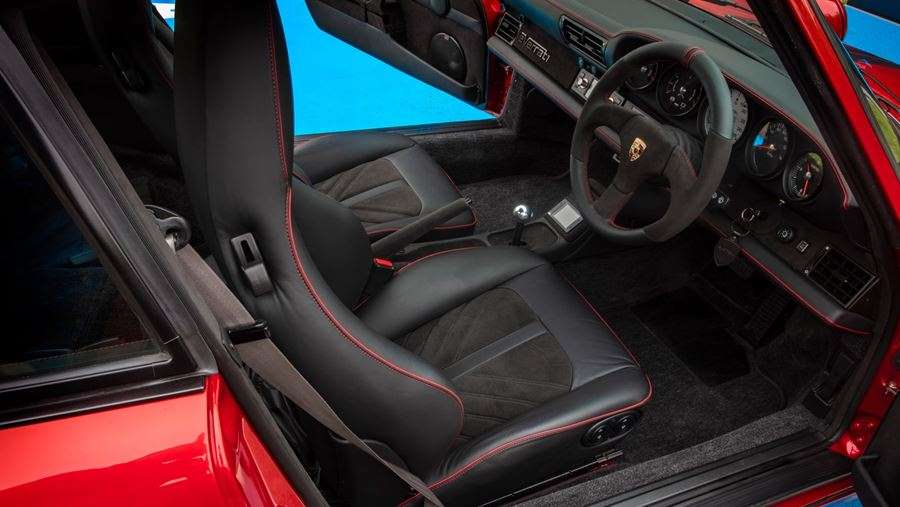
Speaking of weight, Everrati has the aim of keeping the each of the electric 911s it makes as close to the standard car as possible. The 53kWh battery pack is split into two, housed beneath the front and rear bonnets to maintain the car's 40:60 front/rear weight balance. A single e-motor drives the rear wheels, producing 500bhp and 369lb ft (even more power than the 964 Turbo S could ever claim). Everrati claims around 150 miles on a single charge – not a huge number, but the team see this as an 'A-to-A car' – something to go for a drive in when you have some free time, rather than an entirely usable daily driver – given the clientele will almost certainly have fat enough wallets to have more than one car in the garage.
Everrati says the entire process can also be reversed, if the owner changes their mind, allowing the engine and transmission to be refitted. If you stick with the EV powertrain, the team also offers to refurbish the engine and keep it in storage, or even make it a piece of art for your home.
As for dynamics, Everrati includes electronically adjustable suspension, allowing you to attack a B-road with a stiff setup or go grand touring with a squishy motorway one. Every model built also features a Quaife differential for the driven wheels and renewed Brembo brakes with drilled, ventilated discs.
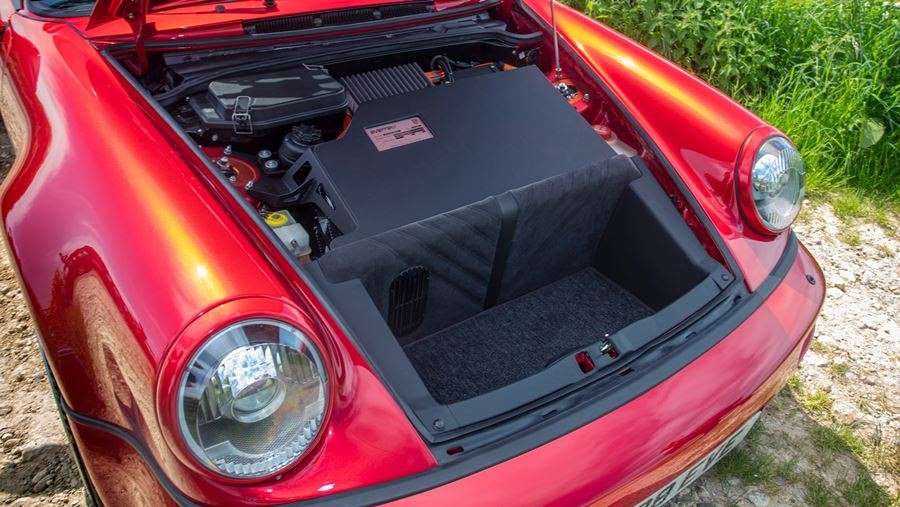
Inside, it's still very much a 964 – clean and simple but with all the key switchgear in the same place – albeit with a few changes. The original seats are overhauled with four-way electrical adjustment, Porsche's Classic Communications Management system is installed in the dashboard to allow for thoroughly 21st century tech like Apple CarPlay, DAB and navigation. The dials are in keeping with Porsche's original design, but the info displayed is very much geared (wired?) towards the electric powertrain, showing the car's state of charge, power and cooling. Our test prototype was swathed in Alcantara, too.
Does it do clever EV things?
It does. There's regenerative braking if you lift off the throttle, with the option to enable regen fierce enough to drive with one pedal. Everrati has engineered in both AC and DC charging via a CCS socket, allowing your electric 911 to be charged at up to 100kW and a 10 to 100 per cent charge possible in under an hour.
When the car launches, it will have both Sport and Eco modes for the powertrain, with Sport being the default and Eco restricting throttle response.
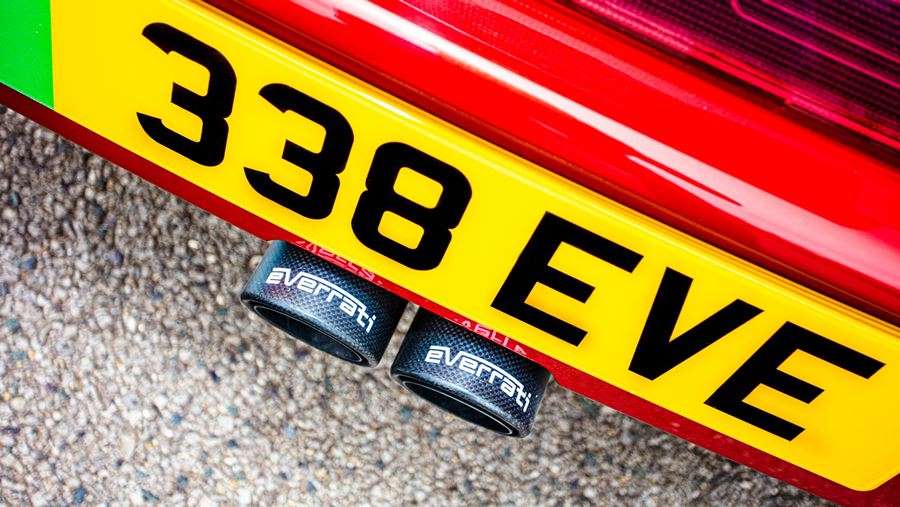
As an aside, Everrati is also developing a sound system capable of emitting engine noises that you can modify via an app tuned to the car's speed, even including throttle blip sounds when you slow down. The tech was in its early stages when we tested it, but the team want the finished product to have speakers both outside and inside the car for the best experience. You can, of course, turn it off if you're so inclined.
Mike Kerr, Everrati's engineering director, who's had roles at Lotus and McLaren (including being the brains behind the new Artura's gearbox), told us that future development ideas include programming in torque steps to the motor to mirror the gear changes of the donor car. Everrati is also open to the possibility of better battery chemistries coming along that can increase range being fitted into the 911 creation after it's already been restored.
Come on then, how does it drive?
Well, first things first, turning the starter key to the eerie sound of silence is a little odd. Your mind takes a few minutes to adjust to a gorgeously restored 964 being active and ready to drive without a so much as a whisper. But it takes mere yards at the wheel to get over it as other, better, sensations wash over you one by one.
First is the steering. It's just so gorgeously weighted and accurate; sharp turns require a little muscle as your hands grip the petite Alcantara wheel, but you know exactly where the wheels are. Even on a straight road, the slightest flex from your bicep or twitch of your wrist translates into a microscopic change of direction. That's not a complaint: it's incredibly rare to find something modern with such alert steering in a modern car, bar the electronically assisted rack of a Ferrari Roma or 488 Pista. Gorgeous.
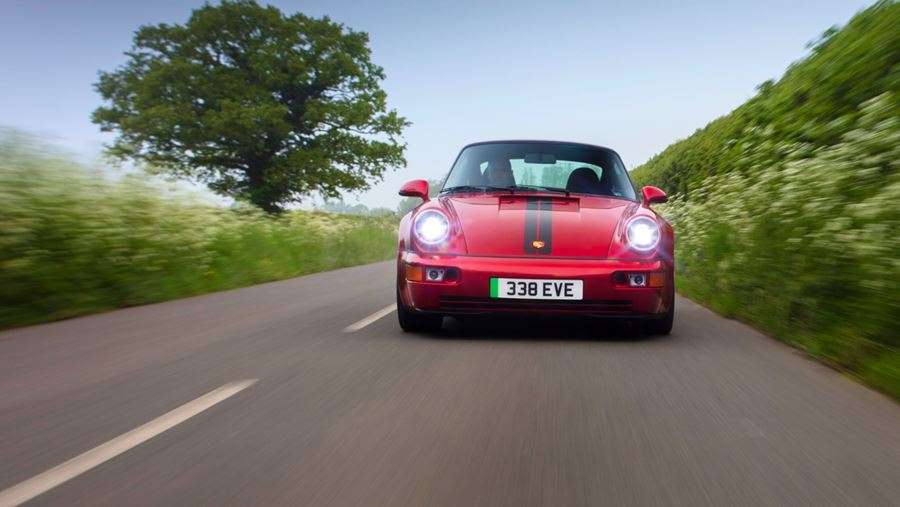
The suspension works exactly as intended, allowing you to firm up or slacken off the damping. We tried the setup in its hardest format and a more road-ready tune – the former added a sharper edge to the dynamics, allowing you to carve up corners with precision, the latter meant I could cruise in peace on a dual carriageway. There's some tyre noise, of course, but an original would have some, too.
As for the performance, it's... well, it's electric. Obviously. The way this thing shifts is more than enough to keep most supercars honest in a flat out drag race. And, very much unlike the wayward 964 Turbos of yore, the grip on tap allows you to hoof it mid-corner with confidence. The regenerative braking on the throttle took a little time to get used to, and I suggested to the team that an on-the-fly ability to change how much regen (allowing the car to coast on the motorway, for example) would be a bonus.
Of course, it's not a flat-six, with all of the additional involvement that brings to the mix. The addition of the 'engine' sound system helps to curb that to some degree, but there'll still be some classic car faithful that won't be able to get on with the lack of a combustion engine. Regardless, the Everrati 964 is eye-widening in how it delivers pace.
Everrati 911 Signature: verdict
Purely on objective terms, the small range, cost and the removal of one of the most iconic traits of a 911 – its flat-six engine – will be enough to cast this Everrati creation aside for some.
But the 911 even as a brand-new car is on borrowed time; even Porsche is looking at how to electrify its icon in-house. And behind the wheel of Everrati's creation, I couldn't stop smiling. The steering, suspension, atmosphere inside and sheer pace of the 964 Signature are plenty enough to involve you. It's still very much a 911 in the way it drives, which is something Everrati can be truly commended for – the stereotype of EVs being naturally heavy and inert to drive is simply untrue here. It also means it's entirely possible for OEMs to create fantastic-to-drive EV sports cars.
If the idea of futureproofing your classic for the zero-emission age sounds appealing, and you have plenty of dosh, it's at least worth giving Everrati a call.
(carmagazine.co.uk)

